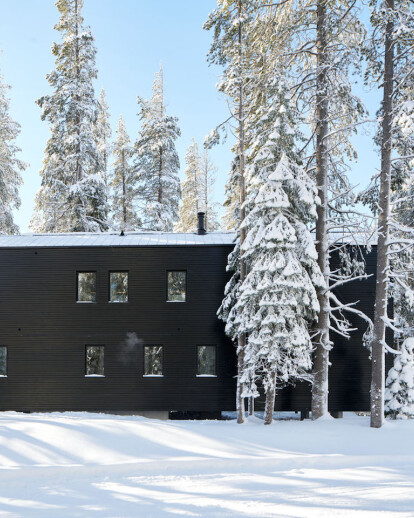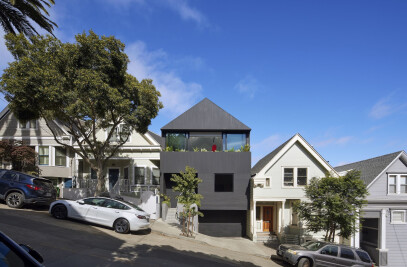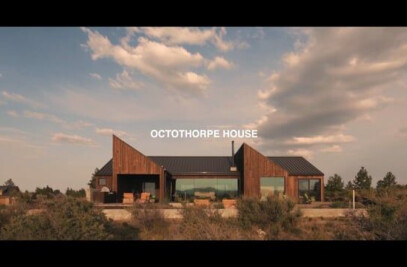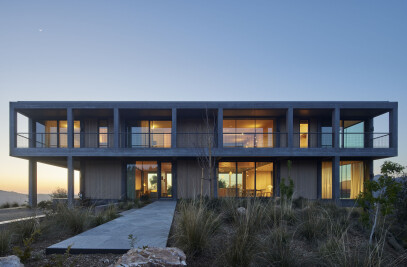Detached from the terrain and attuned to its natural environment. Troll Hus by Mork-Ulnes Architects. Mork-Ulnes Architects just completed a warm, contemporary retreat in a ski village perched atop Lake Tahoe’s Donner Summit, in northern California. Troll Hus was commissioned by a retired couple as a second home for their three children and partners, and seven grandchildren. A welcoming mountain haven for an extended family of fifteen, the home has a constant visual reference to nature. The house was completed in January 2016.
The place Sugar Bowl is a ski resort perched atop Lake Tahoe’s Donner Summit in the Sierra Nevada, in northern California. It sits on a gentle slope at an altitude of 6,800 feet (2,000 meters), in an area that becomes snowbound in winter and where the annual snowfall can exceed 800 inches (20 meters).
The clients The owners, a retired couple in their 70s, commissioned Mork-Ulnes Architects to design a vacation house there for their three children and partners, and seven grandchildren: three ski-loving generations whose older members have been skiing in the area since the 1940’s.
The concept Tucked away in the mountains and nestled into a high alpine forest, the design responds to the owners’ desire for a modernist, rather secluded refuge with a constant visual reference to nature. The site is, in this sense, rather atypical to a mountain setting in that it minimizes expansive lookouts, while in fact emphasizing views towards the glade intimacy of the adjacent landscape, thus allowing for the remote and sheltered retreat the clients were seeking.
”We call the house Troll Hus, with a reference to the otherworldly beings in Norse mythology and Scandinavian folklore that are said to dwell in remote mountains.” says architect Casper Mork-Ulnes
His Norwegian origins very much influenced the way he conceived the house. Though definitely less small and basic, its simplicity recalls the log cabins of his childhood. It is Scandinavian practicality combined with Northern California’s ‘cando’ spirit of innovation that makes the house unique.
The building footprint was kept as compact as possible to settle quietly into the site, yet also capture filtered views of the surrounding landscape. The inspiring concept is that of a tree house that, as if suspended between treetops, seamlessly and ingeniously blends with its surroundings.
With a contemporary nod to the traditional mountain vernacular of the Arlberg Valley in Austria, that the architects had visited on more than one occasion and that has a wonderful tradition of modern alpine architecture, the essential diagram for the house is straightforward: take the alpine chalet building type and lift it onto a concrete plinth to protect it from the snow. Influenced by the prevailing wind-drift direction, the east-west orientation also shields the building from the street and from a popular cross-country trail to the north, while directing views to a private nearby creek and forest beyond. The plan reduces glazing along the entirety of the northern facade to a minimum, since bathrooms, closets and storage spaces are placed on that side of the house. The northern facade is thus rather private, punctured with few necessary openings but essentially turning its back to the public and minimizing heat loss. In order to maximize solar exposure, the south side is where all the main living and communal spaces, as well as decks that run across the volume’s long sides on each floor, are arranged.
The house is essentially elevated on a concrete plinth that allows its inhabitants, when snow settles in winter, to use the protected base as a changing and storage room for ski gear. The second floor thus effectively becomes the house’s entry level accessible both through the enclosed staircase on the first floor and, in the summer, through an external staircase that leads to the southern terrace.
The program The interior arrangement was established with consideration of the client’s needs. The three adult children’s bedrooms and bathrooms (one single and one jack-andjill), as well as the bunk bedroom for the seven children and its bathroom, are located on the second floor. The grandparents’ master bedroom and bathroom and the communal living area, where the family members spend most of their time, are on the top floor. The large space of the living room and of the dining room with its open-plan kitchen is wholly glazed toward the west and south, opening up the interior to the outdoors. In the summer, the family can enjoy a semi-external terrace, protected by the roof overhangs; in the cold winter months they can retreat to the inner living room while still capturing views of the thick canopy of evergreen trees. The north-south angled sloped roof is designed to shed snow easily, while at the same time covering all outdoor terraced areas. The large roof overhangs prevent overheating in summer while admitting as much winter sunlight as possible. An open staircase, flooded with sunlight coming from a dramatic skylight, connects all three levels of the house. A second skylight sits right above the dining table, creating a focal point and highlighting the sculptural angles of the lyed douglas fir ceiling.
”The owners were looking for a relaxed, welcoming environment. We suggested an interior atmosphere that is simultaneously cozy and airy. We went for a stripped down, almost purified aesthetic. Simplicity is luxury,” affirms Lexie Mork-Ulnes, the architect’s wife who was in charge of all the interior design for the house.
The interiors The interiors of the house are completely wrapped in warm wood, that is used for the floors and ceilings as well as for some of the custom-made furniture that Lexie designed specifically for the project, such as the dining table bench and the bar stools. Bespoke furniture is combined with Scandinavian designs and with antiques, like the draw leaf table in the dining room or the cricket table refinished in lye in the living room, that come from the collection of the client, a retired antiques dealer.
”Lye, or lut, is a substance that is frequently used in Scandinavia for cleaning and bleaching wood, and for curing cod fish (lutefisk).”
The exteriors The house exterior is clad in 2x4 solid timber that is coated in black tar, a traditional Norwegian technique, dating back to the medieval stave churches, to help protect the wood from the weather and insects.
”The distinctive black hue of the house helps it recede among the tree trunks of this wooded site, and at dusk the interior, finished with minimally treated fir, glows warm through the windows. The retreat is completely attuned to its natural environment,” says Casper Mork-Ulnes.
The challenge The biggest challenge was building a house in a place that becomes snowbound in winter.
”Scheduling construction was of the essence. The main structure was built during the summer, when trucks can still access the site. By late autumn of 2013 we shrink wrapped the building, so the contractor could continue working through the cold of winter, sparing the expense of continuous snow removal, and limiting traces of the process on the landscape. Snowmobiles and sledges were used to bring workers and construction materials to the site,” recounts the architect.
THE PROJECT Located in the Sugar Bowl Ski Resort, 2.5 hours northeast of San Francisco, this 5 bedroom ski cabin was designed for 3 generations to enjoy simultaneously. The essential diagram is straightforward: take the alpine chalet building type and lift it onto a concrete plinth to protect it from the snow. Located at an elevation of 6,800 feet (2,000 meters), the building needs to withstand extreme snowfall that can exceed 800 inches (20 meters). The residence’s positioning on-site, however, is more nuanced. Influenced by prevailing wind-drift direction and other climatic factors, the orientation shields the building from the street and directs views to a private stream and forest beyond. Living spaces are arranged along the open, south-facing facade to maximize solar exposure. The shaded northern face contains utility rooms where small punched windows draw in indirect northern light but minimize heat loss. Tar-treated wood siding recedes among the tree trunks of this wooded site, and at dusk the interior finished with minimally treated fir glows warm through the windows.

































